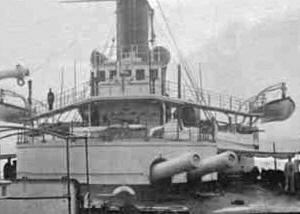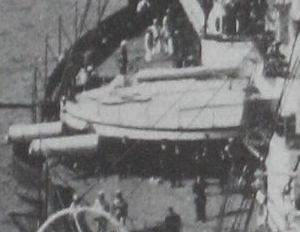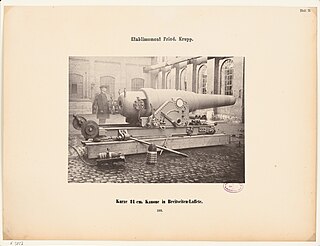
A rifled muzzle loader (RML) is a type of large artillery piece invented in the mid-19th century. In contrast to smooth bore cannon which preceded it, the rifling of the gun barrel allowed much greater accuracy and penetration as the spin induced to the shell gave it directional stability. Typical guns weighed 18 tonnes with 10-inch-diameter bores, and were installed in forts and ships.
A rifled breech loader (RBL) is an artillery piece which, unlike the smoothbore cannon and rifled muzzle loader which preceded it, has rifling in the barrel and is loaded from the breech at the rear of the gun.

The Armstrong RBL 7-inch gun, also known as the 110-pounder, was a heavy caliber Armstrong gun, an early type of rifled breechloader.
A muzzle-loading rifle is a muzzle-loaded small arm or artillery piece that has a rifled barrel rather than a smoothbore. The term "rifled muzzle loader" typically is used to describe a type of artillery piece, although it is technically accurate for small arms as well. A shoulder arm is typically just called a "rifle", as almost all small arms were rifled by the time breechloading became prevalent. Muzzle and breechloading artillery served together for several decades, making a clear distinction more important. In the case of artillery, the abbreviation "RML" is often prefixed to the guns designation; a Rifled breech loader would be "RBL", or often just "BL", since smoothbore breechloading artillery is almost nonexistent. A muzzle loading weapon is loaded through the muzzle, or front of the barrel. This is the opposite of a breech-loading weapon or rifled breechloader (RBL), which is loaded from the breech-end of the barrel. The rifling grooves cut on the inside of the barrel cause the projectile to spin rapidly in flight, giving it greater stability and hence range and accuracy than smoothbore guns. Hand held rifles were well-developed by the 1740s. A popularly recognizable form of the "muzzleloader" is the Kentucky Rifle, which was actually developed in Pennsylvania. The American Longrifle evolved from the German "Jäger" rifle.

An Armstrong gun was a uniquely designed type of rifled breech-loading field and heavy gun designed by Sir William Armstrong and manufactured in England beginning in 1855 by the Elswick Ordnance Company and the Royal Arsenal at Woolwich. Such guns involved a built-up gun construction system of a wrought-iron tube surrounded by a number of wrought-iron strengthening coils shrunk over the inner tube to keep it under compression.

The BL 12 inch naval gun Mk I was a British rifled breech-loading naval gun of the early 1880s intended for the largest warships such as battleships and also coastal defence. It was Britain's first attempt to match the large guns being installed in rival European navies, particularly France, after Britain transitioned from rifled muzzle-loading guns to the modern rifled breech-loaders somewhat later than the European powers. Mks I - VII all had a barrel of approximately 303 inches in length and similar performance.

The RML 10-inch guns Mk I – Mk II were large rifled muzzle-loading guns designed for British battleships and monitors in the 1860s to 1880s. They were also fitted to the Bouncer and Ant-class flat-iron gunboats. They were also used for fixed coastal defences around the United Kingdom and around the British Empire until the early years of the 20th century.

The RML 9-inch guns Mark I – Mark VI were large rifled muzzle-loading guns of the 1860s used as primary armament on smaller British ironclad battleships and secondary armament on larger battleships, and also ashore for coast defence. It should not be confused with the RML 9-inch Armstrong Gun, used by the Dutch navy, the Spanish Navy, and other navies.

The RML 12.5-inch guns were large rifled muzzle-loading guns designed for British battleships and were also employed for coast defence.

RML 16-inch 80-ton guns were large rifled muzzle-loading guns intended to give the largest British battleships parity with the large guns being mounted by Italian and French ships in the Mediterranean Sea in the 1870s.

The RML 12-inch 25-ton guns were large rifled muzzle-loading guns of mid-late 1800s used as primary armament on British ironclad turret battleships and coastal monitors, and also ashore for coast defence. They were the shorter and less powerful of the two 12-inch (305-mm) British RML guns, the other being the 35-ton gun.

The RML 7-inch guns were various designs of medium-sized rifled muzzle-loading guns used to arm small to medium-sized British warships in the late 19th century, and some were used ashore for coast defence.

The British RML 8-inch 9-ton guns Mark I – Mark III were medium rifled muzzle-loading guns used to arm smaller ironclad warships and coast defence batteries in the later 19th century.
The RML 25-pounder gun was a British rifled muzzle-loading light siege gun and gun of position designed in 1871. It was intended to be an intermediate gun between the 16-pounder and 40-pounder Rifled Muzzle Loading guns. It was part of a series of guns designed after the British military reverted to rifled muzzle-loading artillery until a more satisfactory breech-loading system than that of the Armstrong guns was developed.

The Dutch naval gun 28 cm A No. 1, or 28 cm L/22, was the first of a few 28 cm Breechloader Krupp guns used by the Dutch navy. The 'A' stands for Achterlader, the Dutch word for Breechloader.

The RML 16 cm No. 3, or Getrokken kanon van 16 cm No. 3 was a rifled muzzle loading gun. It was a Dutch attempt to cheaply provide rifled ordnance to its navy.

The RML 7-inch Armstrong Gun was a rifled muzzle loading gun. It was an export version of the British Royal Navy's RML 7-inch gun. The RML 7-inch Armstrong Gun was produced by William Armstrong's Elswick Ordnance Company.

The 17 cm RK L/25 was a gun from a family of German naval artillery guns developed in the 1870s. Before World War I, the gun was used on warships of the Imperial German Navy, the Royal Netherlands Navy, and other navies.

The 24 cm K L/20 was a 24 cm caliber Krupp gun which was the first heavy Ring Kanone or built-up gun used by Germany. It was a rifled breech loader with a Krupp cylindroprismatic sliding breech and a Broadwell ring.

The EOC 12-inch L/23.5 or '39-ton breechloading gun' or '40-ton breechloading gun', was an experimental breechloading gun designed and manufactured by the Elswick Ordnance Company also known as Armstrong. The gun was made to profit from recent discoveries about how gunpowder behaved. These required longer guns and made muzzleloading troublesome. The gun seems to have been a failure.



















